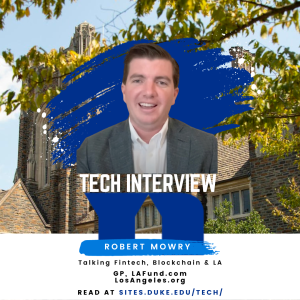The Duke Technology Blog recently had the privilege of interviewing Robert Mowry, an emerging manager running Early Stage LA, focusing on the dynamics of venture capital in Los Angeles and San Diego. Mowry, with his extensive experience in fintech, delved into various technology topics, providing insights unique to his background. He emphasized the differences in investment landscapes between the two cities, reflecting on how regional characteristics influence venture strategies. Significantly, Mowry offered his insights on maximizing value in the fast-paced tech industry, underscoring the need for flexibility and forward-thinking. His expertise as a fintech fund manager brought depth to the conversation, providing essential guidance for investors and budding entrepreneurs alike.

DTB (Duke Technology Blog): I appreciate your sitting down with us to talk tech, Robert.
Mowry: I’m delighted to have had the opportunity. I hold Jimmie Lenz’s efforts in high regard for developing the blockchain curriculum at Duke, and taking a class under his guidance has broadened my view as an educator.
D: Let’s start with that. How long have you been a technology educator?
M: In 2019, recognizing a gap in blockchain-focused education in California, I proposed a certificate program at my local California State University in San Marcos. Once it received administrative approval, I developed the coursework and began promoting it to computer science students and others interested in the field.
Two years after initiating the program, UCLA recruited me to teach the coursework, driven by Los Angeles’ growing interest in using blockchain for innovative ventures. This included crowdfunding for movies, creating digital art through non-fungible tokens (NFTs), and developing community-building initiatives within the metaverse.

D: What three things about blockchain education would surprise the average person?
M: One: How much one can do with a modest amount of specialist education. So few people double down into the developer or organizer side of being a blockchain specialist, much less get a blockchain technology management certificate from UCLA, that there are far more opportunities for management-level positions in blockchain than one might think. I’ve seen students from entirely different career paths land leadership roles in blockchain organizations right after earning their certificate, a development that they often find delightfully unexpected.
Two: How much standardization there is. Smart contracts are code-based agreements between two parties using the fairly simple Solidity language. They’re typically built on well-audited, standard foundational contracts from sources like OpenZeppelin, used as a default. It’s similar to using a standard MLS contract in real estate transactions. In blockchain, straying from the standard can lead to vulnerabilities, potentially causing significant issues for a protocol. So, why risk deviating from what’s already established and trusted? That said, there’s far less coding required because you’re dealing with the same contracts repeatedly than if you were a backend developer looking at various languages and unique situations daily.
Three: The brilliant brains focused on blockchain. My Dad ran an Apple store in LA during the 1980s and coded for corporate clients like SDGE. He often said that being early in a technology field levels the playing field, allowing your determination to be your success driver. This is a much more favorable situation than trying to become the world’s top patent attorney, where you’re up against decades of experience. In fields like that, catching up is almost impossible. Smart people understand this and direct their enormous talents to frontier technologies.
D: After a decade in cryptocurrency, what are your major lessons from this dynamic field?
M: As a management consultant for family offices looking to develop algorithmic trading bots for this emerging asset class, I gained deep familiarity with the crypto industry. I was responsible for setting up algorithmic trading bots right from the launch of FTX, and managing API connections. Through this, I came to know many influential figures in the industry, including one infamous one, Sam Bankman-Fried. This experience also gave me a clear understanding of the complex regulatory landscape in the U.S. and other countries with established financial and securities infrastructures.
The UCLA curriculum centers on distributed ledger technologies and enterprise blockchain, catering to the significant demand from California’s tech firms aiming to develop using both public and private blockchains. While we do cover cryptocurrency to an extent, primarily to understand its applications, it’s been a major force in areas with more flexible regulations and evolving financial infrastructures.
I’ve benefited from a cautious approach towards technologies, allowing counterparties to remain anonymous. This anonymity can sometimes skew people’s moral compass, as they see significant potential gains with little to no potential downsides.
Experiencing hacking, phishing, spear phishing, or some form of social engineering is almost like a rite of passage in this field. From early setbacks like being conned out of millions of Dogecoin, I’ve learned crucial lessons: always move crypto off exchanges before sleeping, question everything instead of taking it at face value, and scrutinize the blockchain to verify any claims made to me. Trust, but always verify.
D: What led to your decision to establish a fintech fund dedicated to investing in these technologies?
M: As a tech equity analyst for family offices, I created due diligence reports for the investment committee and presented my findings to the Chief Investment Officer to provide a thorough basis for informed decision-making. After completing a series of these reports, the CIO, having developed trust in my research and seeing the outcomes often align with my predictions for both invested and non-invested ventures, suggested allocating funds for me to manage directly. This, he joked, would afford him more time for golf.
Even while serving as a tech equity analyst at Tech Coast Angels, Southern California’s largest angel investing group, I didn’t immediately see the full potential of having a 20% carry in a sizable portfolio of investments. I focused on the tech, somewhat overlooking the substantial rewards afforded a general partner in a successful venture fund. However, after a deeper analysis of the possible rewards, I quickly grasped the magnitude of this opportunity, leading me to embrace it and embark on my current path.
D: With an 85% decline in venture capital, numerous emerging managers have closed up shop. How do you account for your resilience and ability to continue operating in these challenging market conditions?
M: I have the strongest conviction in this asset class of any other, particularly when treasuries stand at 5%. Given the risk profile of different assets, limited partners look for returns at least triple the treasury rate, a goal not typically met by traditional investments like real estate, stocks, or bonds. While you may find similar appreciation in alternative assets like Lego, fine art, or other collectibles, venture capital is unique in its capacity to absorb millions of dollars and effectively counteract rampant inflation.
D: Why fintech over every other venture focus?
M: Despite the advanced nature of the U.S.’s financial infrastructure compared to other nations, it desperately needs modernization. Investing in the technologies that will transform major banks and brokerages, transitioning them from the 20th century into the contemporary era, promises to be one of our generation’s most promising investment periods.
D: What do you tell LPs to get them excited about LA-based fintech?
M: I demonstrate my unwavering dedication to this asset class and region, leveraging my management consulting background to illustrate to founders that a process-driven approach to executing repeatable strategies, learned from the success of others, is the most predictable pathway to profitability.
D: What tech hotspots are there within LA County?
M: While many perceive LA as a singular entity, it’s important to note that beyond being the most populous county in the United States, Los Angeles features a multitude of diverse tech investment hubs. Silicon Beach, covering Santa Monica, Venice Beach, and Playa Vista, has thrived as a startup and tech hub, particularly in digital media, e-commerce, and entertainment tech. Downtown Los Angeles (DTLA) has experienced a resurgence, fostering innovation, especially in fintech and urban tech. Culver City’s creative scene has attracted gaming, streaming, and content production companies.
Pasadena, focusing on robotics, AI, and aerospace tech, benefits from institutions like Caltech and JPL. West Hollywood is a hub for influencer marketing, social media, and entertainment tech. Playa Vista, part of Silicon Beach, excels in digital content creation and technology. El Segundo’s concentration of aerospace and defense tech firms has earned it the moniker “Tech El Segundo.” Meanwhile, Long Beach sees growth in logistics, maritime tech, and healthcare innovation. In LA’s various subcommunities, you’ll find something to cater to every interest, as like-minded individuals naturally converge to create hubs centered around specific focuses.

D: How does Los Angeles venture capital differ from San Diego venture capital?
M: San Diego’s venture capital scene is heavily centered on scientific and technological innovations, particularly in biotechnology, whereas Los Angeles features a wider, more varied array of industries, mirroring its diverse economic landscape and cultural fabric.
San Diego’s VC scene is heavily influenced by its strong biotechnology and life sciences sectors, thanks to the presence of renowned research institutions like UC San Diego, my alma mater. This focus has attracted significant VC funding towards healthcare, biotech, and related fields. The city’s VC environment is often characterized by deep tech investments, with a notable presence of specialized, often higher-risk ventures that require specific knowledge and longer-term investment horizons.
Los Angeles, on the other hand, presents a more diverse VC ecosystem. It’s not only home to a burgeoning tech scene, but also to a vibrant entertainment industry, which has given rise to a unique blend of tech and media startups. This diversity attracts a wider range of investors and creates opportunities for cross-sector innovation. The L.A. VC scene is also bolstered by a larger population and a more robust network of accelerators and incubators, fostering a dynamic environment for startups across various sectors, including tech, media, fashion, and even aerospace.
I’m a connector and resource for these vibrant, smart cities I love.
D: How do you best add value as a venture capitalist?
M: Supplier of funding, strategic counsel, and a collaborative accountability partner on the path to an exit.
D: Who is the ideal fit for your career path, and what aspects have you found enjoyable?
M: Technologists who enjoy people. You don’t need to network like a politician, but when it comes to tasks like community building for your fund, attracting investors, connecting founders with potential early revenue partners, and hosting dinners, it’s much smoother when you genuinely care about people and can authentically establish one-on-one connections that build rapport.
D: Why have you advocated for people to build in public and blog about their experiences, ultimately gathering fans who feel connected to their journey?
M: I have a deep passion for reading and writing, and I find that my most productive thinking occurs while I’m in the process of writing. In the Foundational Essay I penned for LA Fund, I aimed to communicate my fundamental beliefs, provide a glimpse of my identity, and present a foundational overview of my goals. I strongly believe that for others to support your work, they must understand what it is!
I urge CEOs to engage in blogging to sharpen their thoughts and bring people along on their journey. This way, when they eventually reach out to these individuals for advice, investment, or as potential clients, they are already familiar with their business and eager to lend their support.
